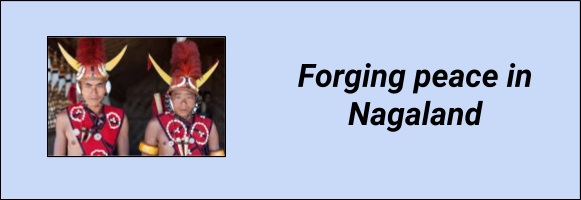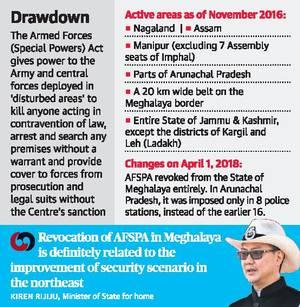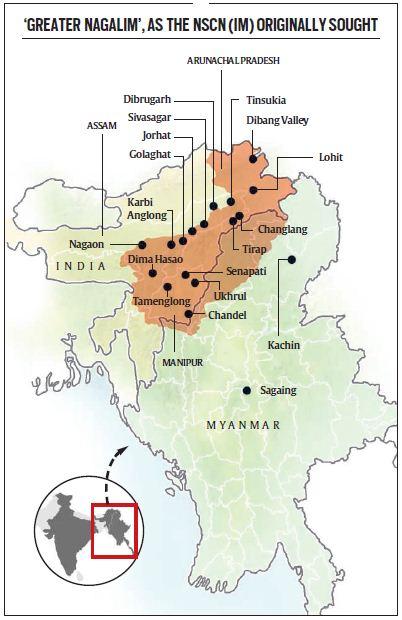(HOT) UPSC Current Affairs 2025 PDF
NEW! The Gist (NOV-2025) | E-BOOKS
Forging peace in Nagaland : Important Topics for UPSC Exams

Forging peace in Nagaland : Important Topics for UPSC Exams
Why in News?
-
The discussion has been running on finalisation of Naga Peace Accord and it is expected to be signed ahead of the Monsoon Session this year.
-
Peace negotiations have been going on between the Issak-Muivah faction of the National Socialist Council of Nagaland (NSCN-IM) and the interlocutor of the government.
Naga Peace Accord
-
To put a full stop to the country’s oldest insurgency, the central government and Naga armed groups have finalised much of the peace accord.
-
The Peace accord will address issues like
-
Autonomous Naga territorial councils for Arunachal and Manipur,
-
Common cultural body for Nagas across states,
-
Integration and rehab of non-state Naga militia,
-
Removal of Armed Forces (Special Powers) Acts (AFSPA) and bicameral House in Nagaland.
-
-
Once the accord is ready, the Naga armed groups will stand disbanded and the non-state armed militia who are eligible will be absorbed in central or state forces and those who are not eligible will be rehabilitated by the government.
Timeline of Events
-
First breakthrough made in 1997 when the ceasefire agreement was sealed after decades of insurgency in Nagaland which started soon after India’s independence in 1947.
-
Framework Agreement signed on August 3, 2015 between Union government and the National Socialist Council of Nagalim (Isak-Muivah), or NSCN-IM.

Demand of NSCN-IM
-
The NSCN-IM has been fighting for ‘Greater Nagaland’ or Nagalim — it wants to extend Nagaland’s borders by including Naga-dominated areas in neighbouring Assam, Manipur and Arunachal Pradesh, to unite 1.2 million Nagas.
UPSC General Studies PRE Cum MAINS Printed Study Material
Online Crash Course for UPSC PRE Exam
Greater Nagaland a tough Solution
-
Territorial Integrity of States of Assam, Arunachal Pradesh and Manipur will get affected by granting Greater Nagalim and at the same time NSCN-IM is also claiming some areas of Myanmar.
-
Naga areas in these states consist of not only Nagas but also numerous other tribes who also claim this region as their homeland with the separate culture of their own.
Framework Agreement
-
Interlocutor R.N. Ravi, on behalf of the Union government, had signed a framework agreement with NSCN-IM on August 3, 2015, to find a solution to the Naga issue.
-
The agreement has raised expectations among the Naga people but also apprehension in neighbouring Assam, Arunachal Pradesh and Manipur.
-
The deal is said to have provided for cultural integration of Naga areas instead of territorial integration.
Issues with the Framework Agreement
-
A section of articulate Nagas have questioned the secrecy around the Framework Agreement and they believe that its terms need to be discussed and debated.
Is NSCN-IM true representative of Naga People?
-
Most in Nagaland speak with contempt about the NSCN-IM because it is led by Th. Muivah, a Tangkhul Naga from Manipur.
-
The question often asked on social media is, why should a Tangkhul Naga decide the future of the Nagas of Nagaland vide the Framework Agreement? But the counter question is why not?
-
NSCN-IM had, for several decades, used the gun to silence its detractors, and indulged in large-scale extortion and imposed its diktat on the Nagas and it has also tried to sabotage platforms such as the Forum for Naga Reconciliation for alternative discourses on the peace process. But to be fair to the NSCN-IM, its leaders have remained steadfast to the goal of wresting an “honourable settlement” for the Naga people from the Government of India.
Nagas and Indian Culture
-
Even today the tribes of this region are not influenced by the “Indian” culture.
-
They are proud inheritors of a unique culture.
Grievances of Naga People and progressive acceptance
-
The Nagas contend that they never signed the Instrument of Accession to India (which the Khasi chieftains of present-day Meghalaya and the Maharajahs of Manipur and Tripura did) and hence cannot be made prisoners to a Constitution they never had a hand in crafting.
-
But at the same time, the Nagas too must admit that they have journeyed a long way with the rest of India and both have developed a comfort level with each other and taken cognisance of the sticking points that prevent the resolution of a long-drawn struggle.
Way Forward
-
Today the Nagas have transcended the victimhood syndrome and shed their hatred for an India once perceived to be the enemy.
-
It is in this climate of mutual respect that the Framework Agreement ought to proceed, which is what drives it.
-
Speaking of a peace deal within the Constitution, let us admit that pluralism is its cornerstone. And pluralism legitimises the compromises that are necessary to negotiate contesting claims in a country like India.
MODEL QUESTIONS :
Q. Which of the following statement is wrong?
A. Greater Nagalim consist the areas of Manipur, Aasam, Arunachal Pradesh.
B. AFSPA has been removed from Meghalaya.
C. AFSPA has been removed from the Nagaland.
D. Framework Agreement was signed between Union government and the National Socialist Council of Nagalim (Isak-Muivah), or NSCN-IM in 2015.
Answer- C


